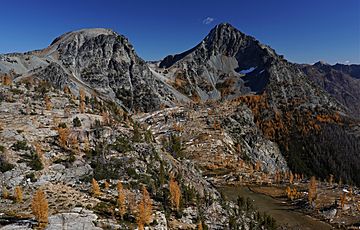Spectacle Buttes facts for kids
Quick facts for kids Spectacle Buttes |
|
|---|---|

Spectacle Buttes from west. South butte (right)
|
|
| Highest point | |
| Elevation | 8,392 ft (2,558 m) |
| Prominence | 1,072 ft (327 m) |
| Isolation | 1.89 mi (3.04 km) |
| Parent peak | Mount Maude (9040+ ft) |
| Geography | |
| Location | Glacier Peak Wilderness Chelan County Washington, U.S. |
| Parent range | Entiat Mountains North Cascades |
| Topo map | USGS Holden |
| Type of rock | Gneissic |
| Climbing | |
| First ascent | 1953 |
| Easiest route | class 3 Scrambling |
Spectacle Buttes are two mountain peaks in Washington state. They are found in the Entiat Mountains, which are part of the larger North Cascades mountain range. These peaks are located in Chelan County.
The taller south peak stands at 8,392 feet (2,558 meters) high. The north peak is a bit shorter, reaching 8,080 feet (2,463 meters). Spectacle Buttes are about 77 miles northeast of Seattle. They are inside the Glacier Peak Wilderness area. This land is managed by the Wenatchee National Forest. The closest higher mountain is Mount Maude, about 1.9 miles away. Water from these peaks flows into the Entiat River. The first people to climb the south peak were Rowland Tabor and Dwight Crowder. They reached the top on August 20, 1953.
Weather at Spectacle Buttes
The area around Spectacle Buttes is east of the Cascade Range. This means it gets a little less rain than places to the west. Summers can be warm, and sometimes there are thunderstorms.
Most weather systems come from the Pacific Ocean. They travel northeast towards the Cascade Mountains. As these weather systems reach the tall peaks of the Cascade Range, they are forced to rise. When the air rises, it cools down and drops its moisture. This moisture falls as rain or snow onto the mountains. This process is called orographic lift.
Because of this, the North Cascades get a lot of rain and snow. Winter months see especially heavy snowfall. Spectacle Buttes are very tall, so they can have snow in late spring and early fall. Winters on the peaks can be very cold.
How the Mountains Were Formed
The North Cascades have some of the roughest land in the Cascade Range. You can see jagged peaks, long ridges, and deep valleys carved by glaciers. Many years ago, big geological events happened. These events created the varied land and huge changes in height. These changes led to different climates and types of plants in the area.
The Cascade Mountains started forming millions of years ago. This was during the late Eocene Epoch. At that time, the North American Plate was slowly moving over the Pacific Plate. This movement caused many volcanic eruptions. Also, small pieces of the Earth's crust, called terranes, joined together. These pieces formed the North Cascades about 50 million years ago.
During the Pleistocene period, which was over two million years ago, huge sheets of ice called glaciers moved across the land. They advanced and then melted back many times. As they moved, they scraped away rock and left behind rocky debris. The "U"-shaped valleys you see today were carved out by these glaciers. The rising of the land and cracks in the Earth's crust (called faulting) combined with glaciation. These forces created the tall peaks and deep valleys of the North Cascades.
Images for kids






